Narcissus is a genus of about 50 species of bulbous perennials. All are grown for their attractive flowers, borne in spring, sometimes in autumn or winter.
Narcissus with single, long trumpet-like flowers is called daffodils. Those with clusters of small flowers on each stalk are called narcissi. There is little botanical difference between daffodils and narcissi.
Narcissus are easy-to-grow, long-lived plants. Individual flowers last for several weeks in cool weather. There are early-season, mid-season, and late-season varieties. There is short and tall growing narcissus.
Narcissus have leafless stems that bear between 1 and 20 flowers. Each flower has six spreading petals that form a flat or long and narrow cup. The flowers are mostly yellow or white, some have red, orange, or pink coronas. The leaves are basal, often strap-shaped.
Narcissus are hardy. Most narcissi need a climate with a cold winter in order to bloom. After flowers finish blooming, it is best to leave the foliage in place for several months; this allows the bulb to store energy to develop the next year’s flowers.
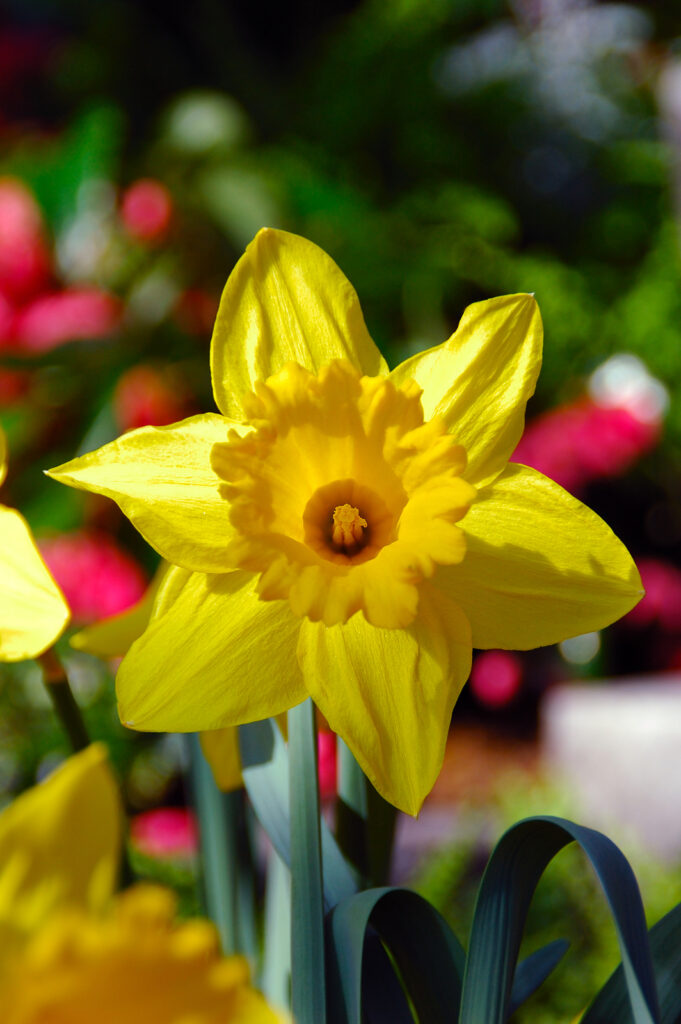
Get to know Narcissus, daffodils
- Plant type: Hardy spring-blooming bulb
- Growing Zones and range: 3-11; most types will grow in Zones 4-8; paperwhites are best in Zones 9-11.
- Hardiness: Half-hardy; most types withstand heat by needing cold winters.
- Height and width: 4 to 18 inches (10-45cm) tall, 4 to 10 inches (10-25cm) wide
- Foliage: Narrow, flat, and strap-shaped leaves from the base of the plant
- Flower form: A central corona shaped like a trumpet or a low cup is surrounded by 6 pointed outer petals. Depending on the variety, each flowering stem holds either a large single blossom or a cluster of 2 to 8 smaller ones. Flowers bloom on a leafless stem.
- Flower colors: Flowers are mostly yellow or white, some have red, orange, or pink coronas.
- Bloom time: Spring for most types, winter for paperwhites
- Uses: Beds, borders, cutting
- Common name: Narcissus, daffodils
- Botanical name: Narcissus spp.
- Family: Amaryllidaceae
- Origin: Europe and North Africa
Where to plant Narcissus, daffodils
- Plant narcissus and daffodils in full sun; late bloomers will grow under the shade of deciduous trees or in dappled light
- Grow narcissus and daffodils in humus-rich, well-drained soil that is neutral to slightly acidic.
- Narcissus prefers a soil pH of 6 to 7.
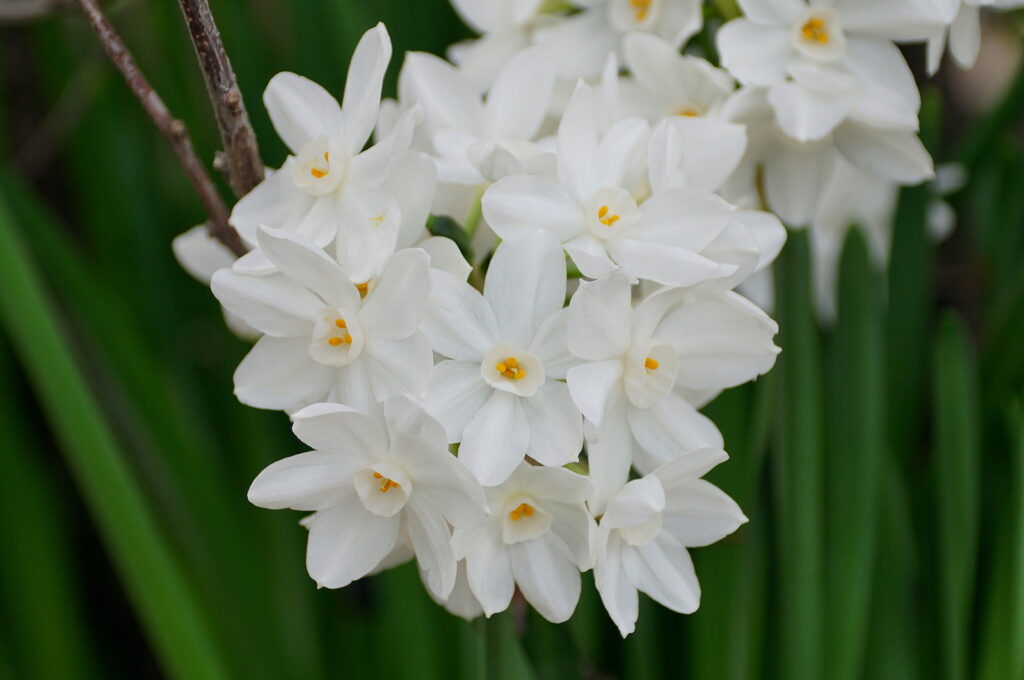
When to plant Narcissus, daffodils
- Plant narcissus and daffodils in mid-autumn in Zones 3-7; plant in late autumn to early winter in Zones 8-11.
- Plant seeds in late spring in nursery beds where they will be naturalized.
Planting and spacing Narcissus, daffodils
- Plant narcissus and daffodils 5 to 8 inches (12-20cm) deep depending on the variety. Work compost and bulb fertilizer into the planting hole.
- A good rule of thumb is to plant narcissus bulbs two to three times deeper than the length.
- Space narcissus and daffodils 6 to 12 inches (15-30cm) apart depending on the size of the variety at maturity.
- To naturalize bulbs in grassy areas or beds, toss them onto the ground wherever plants are wanted and plant them where they fall; use a bulb planter to least disturb the surrounding area.
- Sow seed outdoors 2 inches (5cm) apart, 1/8 inch deep in tilled soil. Fresh seeds will germinate quickly but plants will not bloom for four or more years.
How to water and feed Narcissus, daffodils
- Daffodils and narcissus want ample water during growth and bloom; keep the soil evenly moist, but not wet. The soil can nearly dry out after plants go dormant in summer. Resume water in the fall.
- Add bulb fertilizer or bonemeal to the planting hole at planting time; work bulb fertilizer into the soil each spring.
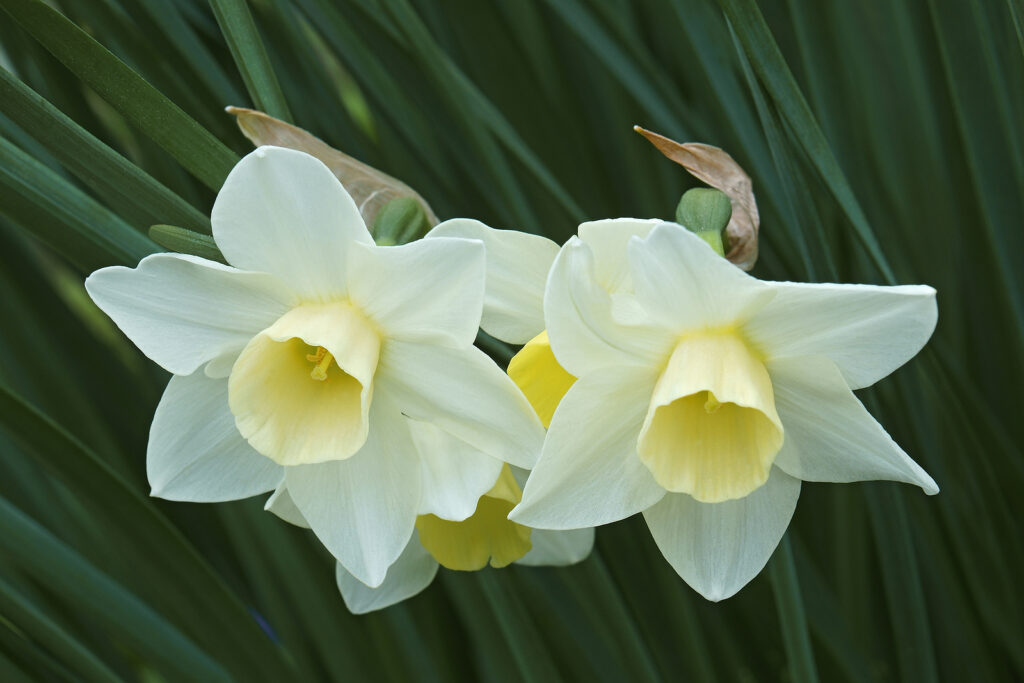
Narcissus, daffodils care
- After bloom, keep moist and fertilize at least once with a balanced fertilizer.
- Deadhead plants or cut flowers send energy back to the bulb.
- Allow leaves to yellow and die; this allows bulbs to store nutrients for the next season.
- Protect narcissus in winter by mulching with 6 inches (15cm) of shredded leaves, pine needles, or straw. Remove the mulch in stages as winter ends allowing shoots to emerge.
Forcing Narcissus and daffodils
- To force daffodils, lift the bulbs at the end of summer. Keep them in a warm, dry place until you are ready to begin forcing. Plant several bulbs in a pot; the point of tall bulbs can be above the soil; small bulbs should be covered with an inch of soil. Water and place them in a cool place at 38° to 45°F (3.3-7.2°C). Roots will form in 10 weeks, plants can then be set in a cool, bright room to grow and flower.
- To force paperwhites, plant them in pots of soil or set them in dishes of gravel or [roopped in glasses of water and growth them in a bright sunlit room between 50° and 70°F (10-21°C).
Growing Narcissus, daffodils as houseplants
- You can purchase plants or force bulbs into bloom yourself.
- To force bulbs into bloom, plant them in a well-drained soilless medium in fall, with the tip of the bulb 1 inch below the surface of the medium.
- Tazetta daffodils can be forced using pebbles as the medium.
- Water well and place the pots outdoors, buried in the ground, or protected in a cold frame for 10 to 12 weeks.
- If the outdoor temperature does not drop to 35°F, bulbs must be placed in the refrigerator.
- Move the pots into a room with average temperature, direct light, and average humidity.
- Bulbs will bloom in 10 days to three weeks. During this time, and until the flowers fade, keep the growing medium evenly moist
- Fertilizing is not necessary.
- Tall plants may need to be staked.
- After flowers fade the bulbs can be replanted in the garden; they can not be forced again indoors.
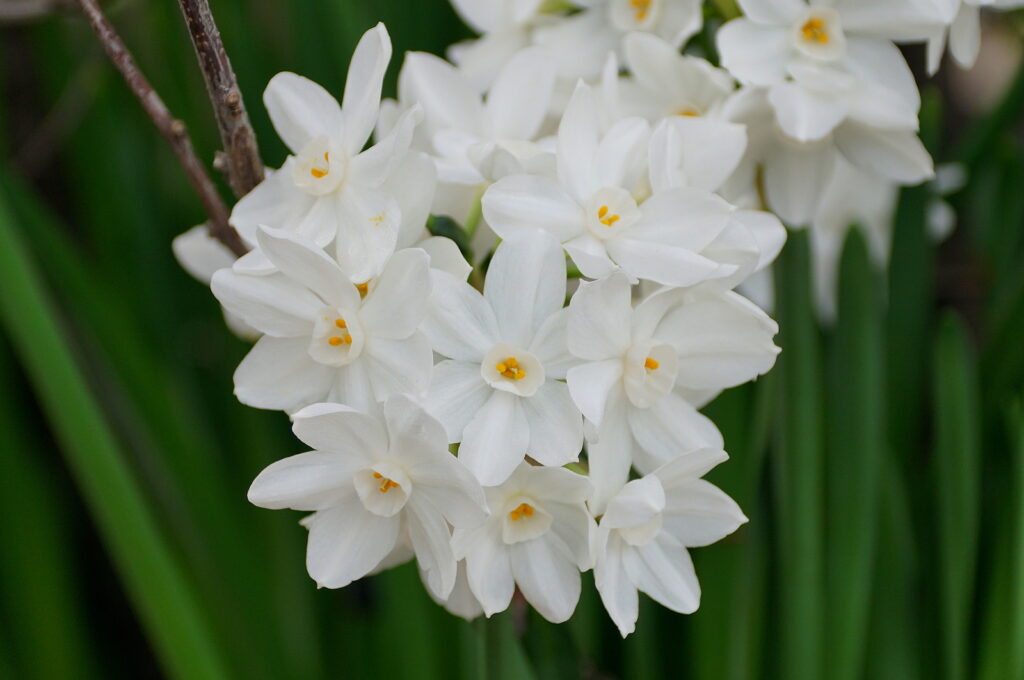
Growing paperwhite Narcissus indoors
The paperwhite narcissus (Narcissus papyraceus) is a variety of daffodil known for its delicate, fragrant, pure white flowers that grow in clusters. Unlike other daffodils, paperwhites do not require a cold period for blooming, making them perfect for forcing indoors during the winter holidays. They are a Mediterranean species, naturally adapted to mild winters, which allows them to grow and bloom indoors with ease.
To grow paperwhites indoors, start by selecting high-quality bulbs in late fall. Plant the bulbs in a shallow container with good drainage, using a potting mix, gravel, or decorative stones to anchor the roots. Place the bulbs with the pointed end up, burying them about halfway in the planting medium, and keep them snugly together for a fuller display. Water the container thoroughly, ensuring that the water reaches the roots but does not submerge the bulbs.
Place the container in a cool, bright spot with indirect sunlight and maintain consistent moisture, but avoid waterlogging. After 2 to 3 weeks, you should see the green shoots emerging, followed by flower buds a few weeks later. For sturdy growth, move the container to a slightly cooler room (55-65°F or 13-18°C) once the shoots appear. With proper care, the paperwhites will bloom in 4 to 6 weeks, adding a touch of beauty and fragrance to your indoor holiday display. To stagger the blooming period, start new plantings every couple of weeks.
Narcissus, daffodils pests and diseases
- Narcissus can be attacked by spider mites.
- Bulb rot and root rot can occur.
Narcissus, daffodil propagation
- Divide bulbs when plants become crowded and flower size begins to decrease, about once every four or five years.
- Dig bulbs for division carefully to avoid injuring the bulbs. Gently pull clumps apart with your hand. Discard shriveled or diseased bulbs
- Replant bulbs immediately or store them in a dry, airy location for replanting in autumn.
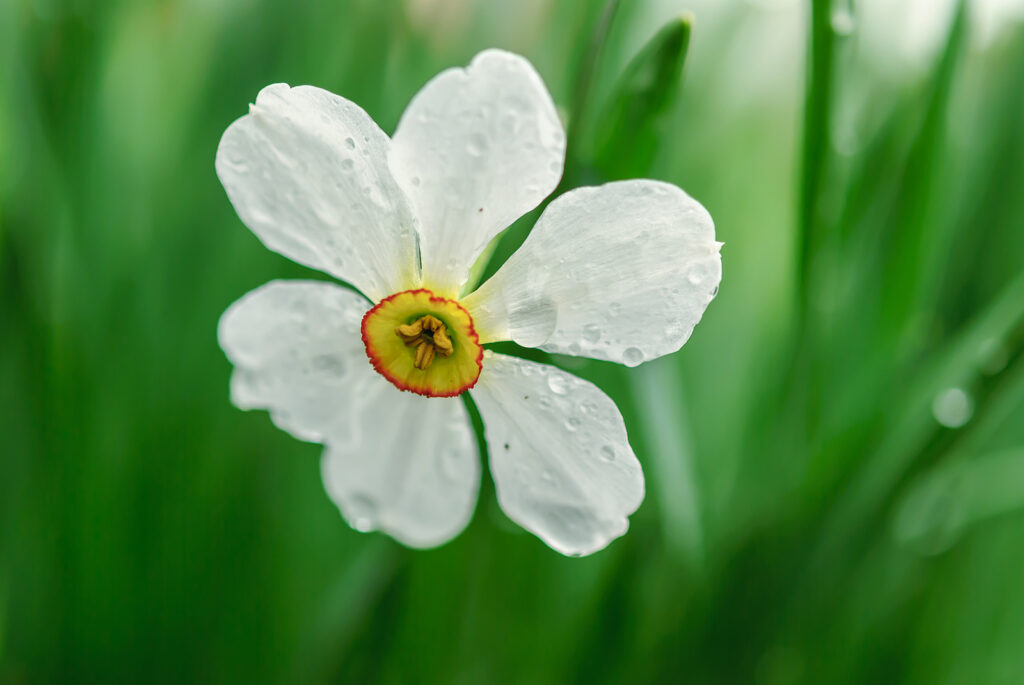
Narcissus, daffodils varieties to grow
- There are hundreds of narcissus cultivars. Growers and hybridizers have divided the cultivars into 13 divisions by sizes, flower forms, and colorings. Flower form divisions include trumpet, large-cupped, small-cupped, double, and split corona.
- Trumpet and large-cups daffodil hybrids are most commonly available and hardy in Zones 3-9, but not where summers are wet.
- Classic, easy-to-grow daffodils include ‘King Alfred’ (yellow), ‘Mount Hood’ (white), ‘Binkie’ (yellow with a white trumpet), ‘Actaea’ (white with red-gold eye).
- Smaller narcissi are classes as trumpet, large-cupped, small-cupped, double, triandrus (clustered), cyclamineus (small, reverse-flared), jonquilla (clustered with trumpets), tazetta/paperwhites (clustered, flat cupped), poeticus (pheasant’s eye), species and wild types, and other for those that can not be classified. Large-cupped, small-cupped, trumpet at the most commonly available narcissi.
Most popular Narcissus to grow
Here are some of the most popular Narcissus varieties that are commonly grown for their beauty and versatility:
- Narcissus ‘King Alfred’ – A classic trumpet daffodil, ‘King Alfred’ features large, golden-yellow flowers with a prominent trumpet shape. It’s a favorite in gardens and naturalized areas for its bright color and early spring bloom.
- Narcissus ‘Tête-à-Tête’ – This charming miniature daffodil produces multiple small, golden-yellow flowers on each stem. It’s compact and ideal for containers, borders, or rock gardens, with early to mid-spring blooming.
- Narcissus ‘Paperwhite’ (Narcissus papyraceus) – Known for its delicate, fragrant white flowers that grow in clusters, the ‘Paperwhite’ is popular for indoor forcing during winter. It doesn’t require a cold period, making it easy to grow indoors.
- Narcissus ‘Ice Follies’ – A large-cupped daffodil, ‘Ice Follies’ has white petals with a broad, lemon-yellow cup that matures to creamy white. It’s widely grown in gardens for its reliable blooms and naturalizing ability.
- Narcissus ‘Carlton’ – This variety features large, golden-yellow flowers with a slightly frilled trumpet and is prized for its sweet fragrance. ‘Carlton’ is a strong grower and naturalizes well in gardens.
- Narcissus ‘Thalia’ – Often referred to as the “Orchid Narcissus,” ‘Thalia’ has graceful, pure white flowers with multiple blooms per stem. It’s popular for its elegant appearance and mid-spring bloom time.
Each of these varieties has unique characteristics, making them suitable for different planting locations, whether for garden borders, containers, or indoor displays.
Narcissus frequently asked questions
Q: How can I grow narcissus as a house plant?
A: Buy bulbs from a reliable source; this will ensure they have been well-grown. Plant in moist bulb fiber, or place in dishes of water and pebbles to which bits of charcoal have been added. Place the bulbs in a cool dark closet or cellar until growth starts. As roots develop bring the plant to more light. Keep it cool. When foliage growth begins to develop, place the plant in a cool, sunny window.
Q: Why do narcissus growing indoors get tall and lanky?
A: They are being grown at too high temperatures. The best daytime temperature is 65° to 70°F. the lower the temperature, the shorter the plants. Moving the plants to a cool garage at night will help keep growth lower and will prolong the bloom time after the flowers open.
Q: Why do narcissus bulbs growing indoors in winter have only leaves and no flowers?
A: The likely reason is that the temperature is too warm.
Q: Can I force next year the narcissus bulbs I forced indoors this year?
A: No. The bulbs will not rebloom indoors a second time. You can plant them in soil outdoors and they may bloom outdoors.
Also of interest:
11 Types of Daffodils for Your Garden















